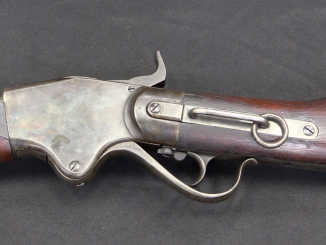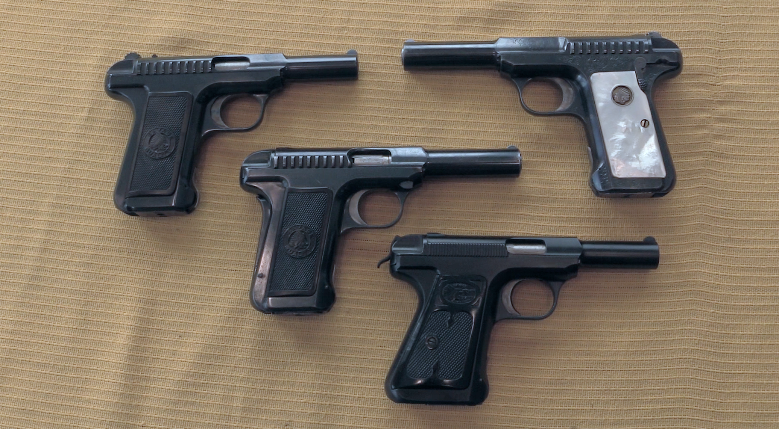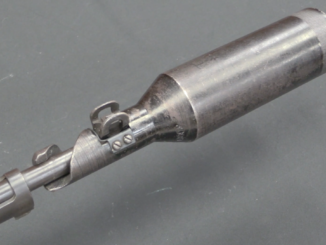The Sisterdale revolver is one of the most original designs of the Confederate revolvers. It was devised by a group of Texans led by one Alfred Kapp, son of a German immigrant in Sisterdale, Texas. He and his compatriots made six of these revolvers on the Kapp homestead with the intention of obtaining a contract to make them for the Texas government and for their own armament during the Civil War.
The plan came to naught, most likely because the revolver’s design left much to be desired. In particular, it features a long flat spring as a cylinder stop on the top strap, and an external hand to rotate the cylinder. Of the six apparently manufactured, only this example is known to exist today, having been passed down for decades by the Kapp family.




Good grief. External hand is a bad idea! Wouldn’t it get jammed in muddy conditions?
http://www.littlegun.info/arme%20americaine/revolver%20confedere/a%20revolver%20confedere%20sisterdale%20gb.htm
states that:
“(…)exposed pawl(…)directly copied from the very early Remington Beals Pocket revolver.(…)”
I am not expert on pre-metallic-cartridge revolvers, but very early suggest that only small % of all Remington Beals Pocket revolver has exposed pawl. I hope more keen users know how many % of Remington Beals Pocket revolver has this feature.
Still… If you had a cast frame, in bronze… The more solid it was the better, I should think.
How did the Remington Beals Pocket revolver, rotate the cylinder, do you know? Conventionally or otherwise.
See patent US17359A:
http://www.google.ch/patents/US17359
True name is Fordyce Beals (but as you can see OCR can contain errors)
Interesting stuff, well found.
He also patented other method of cylinder rotation, which used in Whitney “Beals Patent” Pocket Revolver:
http://unblinkingeye.com/Guns/WBPP/wbpp.html
(patent US11715)
Excellent, thanks.
This looks like it would be a great gun for reproduction just for conversation reasons. I’d get one to go with my repro Remington New Model Army.
There’s a Rocky mountain arms, http://www.gunauction.com/buy/10355752
Mini revolver “NAA type” with a partially similar external cylinder lock system, don’t know if it had the rotation element somehow incorporated. I heard it was designed by that Casull fellow, of Magnum fame. He did a folding trigger model, with a safety- External control, ca2000 it was called, perhaps he saw one of these.
Doesn’t have the same rotation system as this, clearly I.e. External, but it does the lock the same for sure, I heard about it from folks who knew about it had more pictures etc. The rotation thing, might have been achieved conventionally perhaps. Might make sense, if it was incorporated into said unconventional cylinder lock lark- Maybe it was easier to make or something, hence the point.
Seems to have hook, shape, the cylinder locking bar, lifts up by the hammer, maybe it engages the cylinder also somehow, said hook.
The creeping rammer looks like a direct copy of the one on the Colt M1851. The extended forward frame is more like a Dragoon. I suspect it was designed that way because the barrel is most likely wrought iron instead of steel.
Iron barrels were common on Confederate made revolvers due to a shortage of steel to make barrels from. As a result, heavy frames were often used to better reinforce them against powder expansion pressure near the barrel-cylinder gap.
BTW, is that a lengthwise crack on the left upper side of the barrel just ahead of the frame? That could be a barrel failure that occurred during test firing, and might be one reason the project ended so quickly.
The rear sight is small and hard to see, but after all, most revolvers of the time rarely had an actual rear sight to begin with, other than a groove on top of the frame, or in the case of a Colt a notch on the nose of the hammer.
This one also seems to do double duty as a retainer for the cylinder stop leaf spring assembly, which looks like a forged piece that’s been annealed at the front end to act as its own spring. Which isn’t the best way to go about it, really. Although it dos eliminate one part, a separate spring that would have been needed otherwise.
It’s an interesting design, if not all that practical. Still, worse designs were coming from the established gunmakers “up North” at the time, such as the Savage or Pettingill.
At least the Kapps have to be given credit for keeping their design reasonably simple. In a combat weapon, simple is generally good.
cheers
eon
Perhaps it was something to do with casting, the original idea… Confederates made brass frame revolvers, because it was cheaper etc, this bronze lark might explain the external features… If it was cast in bronze to be cheap “war, losing the war” perhaps casting wasn’t great for internal bits, so they came up with external bits- Quite good.
Obviously the casting process left something to be desired, but I mean in principle.
A sort of “high point” revolver.
What “high point” revolver mean?
High point automatic, zamak alloy… Auto, transposed to a cast bronze revolver.
Little help?
http://www.hi-pointfirearms.com/Hi-Point-handguns/9MM_handgun.html
Da?
http://www.littlegun.info/arme%20americaine/revolver%20confedere/a%20revolver%20confedere%20sisterdale%20gb.htm
states that:
the Sisterdale is unique in that it was made by a group of soldiers with the limited possibilities of a simple farm shop.
Remington Beals Pocket revolver, interesting stuff.
“You’ll probably have to search for that a few times, to get an relevant picture- Forgotten weapon”
Brass or bronze frames on Confederate revolvers had more to do with materiel shortages than cost. There just wasn’t enough high-grade steel available in the South to make arms from. Even Southern-
made rifle-muskets generally had barrels and actions of wrought-iron, not steel.
The Griswold & Gunnison and Spiller & Burr revolvers had wrought-iron barrels and brass frames, and the Leech & Rigdon had a wrought-iron barrel, a cast-iron frame, and a brass grip-frame and trigger-guard assembly, for this exact reason.
One thing that’s always amused me about “spaghetti Westerns” is the number of supposed “Colts”, from 1851 to 1873 models, that turn up in them with brass frames. Uberti etc. in Italy have long brass-plated the frames of a lot of their products, apparently not realizing that other than brass-plated grip frames on percussion Colt M1851s and Third Model Dragoons, actual Colts generally didn’t have any “brass” in the frame at all. Only “Confederate Colts” and etc. were built that way.
When you see a brass-framed percussion “Colt” in an Italian-made Western, the “original” should probably have been stamped “Made in C.S.A.”.
cheers
eon
Cost related, naval blockade aside… They couldn’t buy decent metal, and were running out of church bells to melt down.
I think in the civil war, here, folk might have figured holy metal might gain some advantage but that was in the 17th c
http://bloggingtherenaissance.blogspot.co.uk/2006/12/woodcut-caption-6-in-with-old.html
Mmmm.
Eon, the Uberti and other Italian replicas are based on reverse engineering, and more than likely they had several original Colts to examine. So, I think they knew where brass was authentic and where not. For example the Uberti SAA 1873 models are available with both steel and brass frames these days; I don’t know if that has always been the case. Nevertheless, brass does look cooler and these are Italians we are talking about… And in movies, even outside Italy, “cool” usually trumps authentic.
The name Schmidt is a very commen family name in germany, but not used as a first name. Wilhelm on the other hand is commen as a first name at that time in germany.
If Alfred Kapp left germany at 1849 for political reasons, he may involved in the 1848 revolution die Märzrevelution. So he would at that time at the liberal and left side of the polical spectrum. I wounder how that fits with his involvment with the Zivil War.
Rebellion against a central government? That was one of the basic themes of the 1848 revolts across Europe, notably in France.
The “forty-eighters” were the forerunners of the Paris Commune, the Fabians, and by extension the anarchists of the 1890s and the Communards of a decade later. They disagreed with each other nearly as violently as they did with “authority figures”. In fact, about the only thing they agreed about was that they flat-out hated said authority figures. The 1848 revolts were as much a rebellion against the pan-European Metternichism that followed the Napoleonic Wars as they were against individual national governments.
That philosophy would have fit in very well in a lot of the Confederate states. Especially Texas. A lot of people there, if asked, would probably have put Lincoln’s federalism in the same category as Metternich’s philosophy.
cheers
eon
Splitter!
Actually most of the Germans in this area of Texas did not get along with the Csa as they were abolitionists. As long as they didn’t have to fight they got along but when conscription came along major trouble started. This might have affected the history of this pistol. There was a major fight often called a massacre when military aged men of the area tried to leave Texas to ostensibly avoid conscription but there was fear by the local confeds that these Germans were going to enlist in the Union army.
Of course the problem was locAlized and many germans did fight for the Csa .
Going on memory of what I read in the past, I need a refresher
They were on both sides, likely. I recall from my southern experience that there was a unit of Light Bavarian field artillery in ranks of CSA. I learned it thru one interesting encounter with rehearse actor in one famous battle.
Loads of Indians in that area as well I live near Sisterdale on Sisterdale road. Called the Pinta Trail
The Central Texas region, including Kendall County, has supported human habitation for several thousand years. Archeological evidence suggests that hunting and gathering peoples established themselves in the area as early as 10,000 years ago. Lipan Apaches, Kiowas, and Comanches became the dominant tribes in the late eighteenth and early nineteenth centuries and were present when Germans began arriving in the 1840s. The Meusebach-Comanche Treaty, signed in 1847, was to permit the settlers to enter Indian territory to settle and the Indians to enter the settlements. German immigrants established Sisterdale in 1847, Tusculum (Boerne) in 1849, Curry’s Creek in 1850, and Comfort in 1854. Although relations between settlers and Indians were fairly sympathetic, small groups of Indians did make frequent raids on farms in the area, and in some instances killed settlers and stole children. The threat of raids continued through the mid-1870s but lessened as the frontier was pushed farther west.
I think you are close with that assumption. Once freedom minded one place, than freedom-minded everywhere.
In germany, the 48 revolution had also the some aim to unify all the geman kindoms and duchys in one germany with a constitutional king or Keiser. That would also not fit well with the confederat.
“…devised by a group of Texans led by one Alfred Kapp…”
I suppose you could call it a “Kapp and ball” revolver, then.
Writing the dissertation abstract is a hard and important process that require strong writing and editing skills. But with the help of the expert writers, you can receive high-quality assistance.
Reliable religion & theology coursework writing services are not hard to come across for those in need of Religious Research Writing Services and theology & religion essay writing services.
Finding the best English paper writing services and English Language Writing Help is not easy unless one is keen to establish top ranked english language essay writing service provider & English editing & proofreading services.
The cylinder looks like a massive Dragoon type.